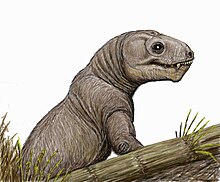Biseridens
| Biseridens | |
|---|---|

| |
| Life illustration of Biseridens qilianicus | |
| Scientific classification | |
| Domain: | Eukaryota |
| Kingdom: | Animalia |
| Phylum: | Chordata |
| Clade: | Synapsida |
| Clade: | Therapsida
|
| Suborder: | † Anomodontia
|
| Genus: | †Biseridens Li and Cheng, 1997 |
| Species: | †B. qilianicus
|
| Binomial name | |
| †Biseridens qilianicus Li and Cheng, 1997
| |
Biseridens ("two rows of teeth") is an
Among
Etymology
Biseri- is Latin for "double rows"; -dens originated from Greek "odons" for "teeth"
Geology and paleoenvironment
At a
On the basis of converging faunal evidence and comparison to other regions, the Xidagou Formation has been considered to be Middle Permian[6] and home to the oldest therapsid fauna, suggesting that anomodonts had a Laurasian rather than a Gondwanan origin.[7]
Discovery
Until the more recent discovery of a new specimen, Biseridens was primarily known from fragmented skull and jaw material discovered in the 1990s in the upper part of the upper Xidagou Formation of Gansu, China.[8] The specimen included an incomplete skull with the posterior portion of the left ramus of the lower jaw and the anterior part of the lower jaws including well-preserved teeth.[8] The more recently discovered specimen includes a nearly complete skull (lacking the occiput) with lower jaws, found with a set of 14 articulated vertebrae. This new specimen was preserved in mudrock and also discovered in the upper part of Xidagou Formation in Dashankau, Yumen in Gansu.[1]
Description
Biseridens is known mostly from
Dentition
There are several diagnostic features that characterize this specimen as a Biseridens. Related to its heterodont dentition, Biseridens is distinct from other anomodonts because of a differentiated tooth row that includes two rows of teeth on both the jaws, precanine teeth on the dentary and premaxilla, and a broad spread of teeth on the pterygoid and palatine. There are also denticles on the vomer, palatine, and pterygoid. The postcanines possess oval cross-sections and have grinding surfaces, and the canines have a basal diameter of 10 mm. There are no serrations on the marginal teeth, which aligns Biseridens within the anomodont clade.[1]
Palate
The paired pterygoid of Biseridens is the most distinctly visible bone on its palate. It contains an anterior process, a quadrate ramus and a ventromedial process. There is a prominent posterolaterally curving transverse curving process. Similar to other basal therapsids, this process reaches much lower than the level of the palate.[1]
Skull
Regarding its skull structure, the features that distinguish Biseridens from other anomodonts include having an intertemporal region that is wider than the interorbital region, and a

Classification
Biseridens belong to the clade
The holotype and paratype of Biseridens were initially referred to Eotitanosuchia, a former
Although relatively primitive, a number of shared traits (
The most recent analysis performed by Liu et al. in 2009 indicates a significantly stable placement of Biseridens as the most basal anomodont based on a matrix study performed on 75 cranial characters over 15 synapsid genera and conclusions of primitive and derived features. Based on the geographic discoveries of Biseridans, the most basal anomodont, Raranimus, the most basal therapsid, with basal dinocephalians, bolosaurids, and dissorophids, there is now strong evidence that the oldest therapsids resided in China.[1]
| Therapsida |
| ||||||||||||||||||||||||||||||||||||
See also
References
- ^ PMID 19640887.
- PMID 12803915.
- ^ King G (1990). The dicynodonts, A study in palaeobiology. Vol. 91. London: Chapman and Hall.
- ^ a b c "Palaeos Vertebrates Therapsida: Anomodontia". palaeos.com. Retrieved 2020-03-04.
- ^ King, Gillian (1988). Anomodontia. Encyclopedia of paleoherpetology. Stuttgart, Germany: Gustav Fischer Verlag.
- ISSN 2296-701X.
- .
- ^ a b c Li J, Cheng Z (1997). "First discovery of eotitanosuchian (Therapsida, Synapsida) of China" (PDF). Vertebrata PalAsiatica. 35 (4): 268–282.
- S2CID 8178585.
- PMID 23741307.
